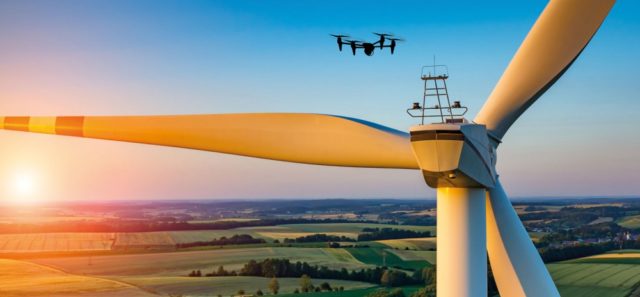Embry-Riddle Aeronautics University used a small unmanned aircraft system (UAS) to study the effects of wind turbines on farmland beneath them and found that they can impact soil, crops and livestock.
Farmers can earn extra income by allowing wind turbines to be placed in their fields. Based on data collected from the UAS, researchers discovered that depending on weather conditions, the spinning blades can positively or negatively impact crop yields. For example, a wind turbine might inhibit crop disease during wet weather or it could speed moisture loss during a drought.
Kevin Adkins, an assistant professor of aeronautical science and director of Embry-Riddle’s Gaetz Aerospace Institute in St. Lucie County, Florida, flew a drone into wind turbine wakes to measure differences in relative humidity levels. He and his colleague Adrian Sescu of Mississippi State University published their research findings in the International Journal of Green Energy.
They found that below the hub of a single spinning wind turbine, relative humidity can decrease by as much as 3 percent downwind while humidity increases above the hub. The researchers concluded that this impact is magnified within a broader turbine array. “This occurs as drier air is mixed downward and moister air is mixed upward,” they wrote.
The research was conducted at two Midwestern wind farms. An instrument-equipped quadcopter was flown into two different wind-turbine wakes where it hovered at key points to collect upstream and downstream data. The hub of one turbine was 305 feet above a field of winter wheat. The second turbine had a hub height of 262 feet. Baseline meteorological conditions were assessed.
The quadcopter was equipped with GPS and a suite of instruments to capture temperature and relative humidity levels. Following a prescribed flight path over a four-day period, it made a series of sweeps through the wind turbines’ wake zone.
After analyzing the data, Adkins and Sescu found that the descending blades were delivering drier air downward, while the ascending blades were displacing moister air upward—away from the surface of crop fields. They believe this could have significant implications for crops, soil and livestock.
“For farmers, reduced relative humidity over fields could have an impact on their crop productivity,” Adkins said. “It’s my hope that farmers will take this new information and utilize it, leveraging their specialized knowledge.”
Most prior investigations of wind-turbine impacts on near-surface meteorology have been based on computer modeling, Adkins said. “The implementation of the unmanned aerial system provides proof of concept for a platform that can also be used for the measurement of other atmospheric parameters with high spatial resolution,” the researchers wrote.
Source: Press Release

